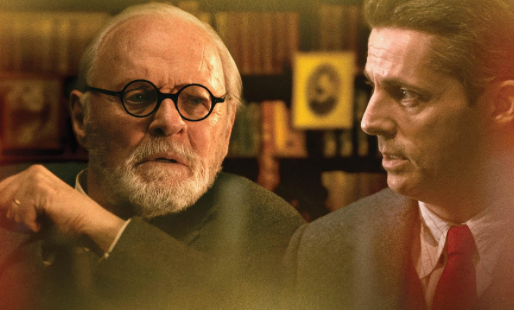“Freud’s Last Session” premiered last October at AFI Fest and will be released on December 22. The film provides a fictional look into a rumored session between Sigmund Freud, played by Anthony Hopkins, and C.S. Lewis, played by Matthew Goode. During the pre-credits of the movie, it is noted that in his final days, Freud did meet with an unknown Oxford professor and the film puts forward this anonymous don may have been Lewis.
The premise of the film is based on the idea that two of the greatest thinkers of the twentieth century, holding entirely opposing views, came together on the eve of World War II, as Germany invaded Poland, to discuss their ideological differences such as their respective disbelief and belief in God. The movie is based on the play of the same name by Mark St. Germain, who helped adapt the movie along with director Matthew Brown, and the play itself is based on the book “The Question of God” by Armand Nicholi. It is clear from the screen adaptation the source material was a stage play as the bulk of the movie is a sometimes heated conversation between the two men.
Beyond the main plot of the day-long discussion between the two intellectuals, are subplots that often, unsurprisingly, delve into human sexuality as it pertains to other characters that round out the cast. These subplots include a look at Anna Freud, Freud’s daughter, played by German actress Liv Lisa Fries (“Babylon Berlin”), and her romantic relationship with fellow child psychoanalyst Dorothy Burlingham, played by Jodi Balfour (“For All Mankind,” “Ted Lasso”), as well as with her codependent relationship with her father, aptly analyzed by others as an unhealthy attachment. Another subplot looks at Lewis’s relationship with the mother of his fallen comrade from World War I, Janie Moore, played by Orla Brady (“Star Trek: Picard,” “Into the Badlands”). The film features a non-linear narrative, flashing back to Freud’s childhood, Lewis’s childhood, Lewis’s time in WWI, and Freud’s life in Vienna just as the Third Reich is coming to power, while also cutting back and forth between their meeting and Anna’s day, which ends up devoted to her father.
Hopkins provides a vibrant performance as the inimitable father of psychology, superb as always. In this production he chose not to adopt an Austrian accent, instead peppering his speech with German phrases to demonstrate his country of origin. Goode manages to hold his own against Hopkins, playing Lewis as the somewhat meek, slightly shell-shocked former soldier and atheist turned preeminent theologian, or as Anna Freud at one point calls him, “The Christian apologist.” Fries and Balfour’s relationship radiates with chemistry, not always positive, and Brady’s portrayal of Lewis’s estranged lover, though brief, is also well done. It is important to note that despite being partners beyond their professional relationship, the Freud Museum continues to ignore Freud and Burlingham’s private relationship even today.
Director Matthew Brown (“The Man Who Knew Infinity”) makes another attempt at bringing the gravity of psychology, philosophy, and existentialism to the screen. Similar to his previous picture, “Freud’s Last Session” digs into a series of weighty topics but does little to unscramble those ideas for the viewers. Meanwhile, the cinematography, led by Ben Smithard (“The Father,” “Downton Abbey”), and production design, by Luciana Arrighi (“The Man Who Knew Infinity,” “The Remains of the Day”), help make the film an exceptional look into the past. The score is provided by Coby Brown, who brings a nostalgic and understated theme to the story.
The film lags in its overall pacing, with its dialogue often heating up, only for the session to cut to a subplot, or vice versa. Other drawbacks include its lack of lighting in most scenes, leaving the film shrouded in shadow. However, its literal and figurative acknowledgment that all humans are inherently flawed, often holding personally conflicting views, is abundantly apparent and can be seen in Freud’s collection of mythical figures adorning his office space, including the fitting Saint Dymphna, patron saint of the mad and lost. Lewis’s contrarian positions are not forgotten from the equation either, with the exploration of his past including a semi-tragic childhood and traumatizing bout in the war juxtaposed with his current attitudes toward religion, with explored concepts such as “God’s plan.”
With this film, Hopkins has now portrayed both Freud and Lewis in two separate films, having played Lewis in “Shadowlands,” at an entirely different period in Lewis’s life.
“Freud’s Last Session” is rated PG-13 for “Thematic material, some bloody or violent images, sexual material, and smoking” and has a lengthy running time, considering its somewhat dragging story, of 109 minutes. The review aggregator site Rotten Tomatoes lists the film as 70 percent positive based on 10 critics’ reviews. Meanwhile, Metacritic, which uses a weighted average, gave the film a mixed score of 57 out of 100 based on the reviews of 4 critics at the time of this writing.
The Photo is a screen capture.
Stay informed. Sign up for The Westside Voice Newsletter
By clicking submit, you agree to share your email address with Westside Voice. We do not sell or share your information with anyone.








